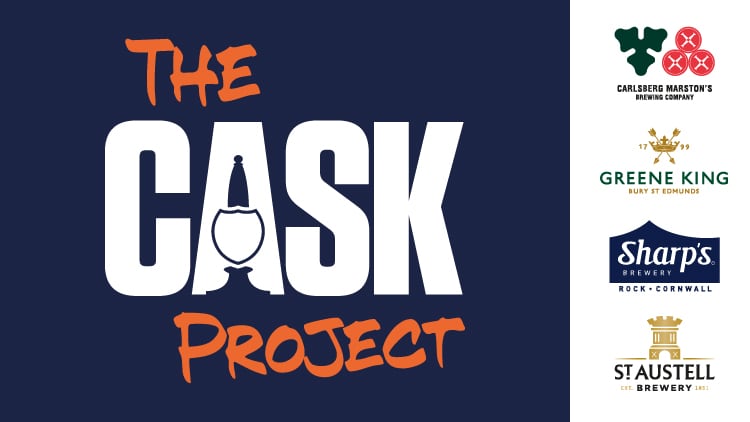
Here, Carlsberg Marston’s Brewing Company (CMBC) technical specialist John Fogg, pictured right, explains how his role could make sure your beer stays in perfect condition.
He has also provided some of the training materials he uses when visiting pubs to teach licensees and staff how to store and serve cask while giving tips on keeping cellars in the best condition possible. To take a look at these, click here.
Q. Tell me about yourself and what your role entails
A. I started working for Joshua Tetley’s Depot in Sheffield, in 1983 as a load planner for radial deliveries, and moved up slowly but surely, through the management grades, and became a technical manager for them in 1991. I then moved up to Tetley’s Leeds brewery looking after refrigeration for about five years. In 2005, Innserve was formed and I became technical manager there and more recently, Carlsberg UK came back four years ago, and plucked me away again.
The joint venture happened with Marston’s when the business became Carlsberg Marston’s Brewing Company (CMBC) and this was a new role for me as a technical specialist and I’ve been in that role since October 21. I’ve been covering all aspects of dispense: Dispense Innovation with CMBC, cask beer my love and joy my role is also focused on reducing operational costs, improving efficiencies within trade and training and education of everything beer quality related or technical for CMBC.
Q. How do customer training sessions work?
A. We’ve had multiple requests from wholesale accounts, free-trade customers and retail chains post lockdown, what we offer is an in-depth training course that covers all aspects of beer dispense theoretical and hands on, covering hygiene, glassware with the focus on quality management. The sessions depend on what the need is we can tailor the courses to that specific need. Normally it’s a CMBC sales-driven request – it could be as simple as a one-to-one training session with a licensee and maybe a few staff but we do larger training sessions too. I have completed several at large venues race tracks multiple operators who have lost staff due to the pandemic and are essentially restarting again with new personnel. Customers are looking for more information education on keg and cask beers generally so we run classroom-style training session with groups of up to 12 people and also individual one to ones. We’re getting very busy and probably average about two to three training sessions a week. We’ve trained about 290 people since October 2021 – that’s a lot of great pints now being served.
Q. Is there any advice you given that seems to stand out with clients?
A. It’s the small details that are not generally known and tips and information relating to all aspects of keg and cask management, for example glassware. Your glass is the last thing the beer sees before you consume it and it’s critically important to keep glassware in order. We’ve got quite a detailed package on, glasswasher awareness, detergents, the glassware themselves, and there are simple tips to keep beer in very good condition, which go down really well. There’s been loads of positive feedback, I have completed a classroom style and practical this week for the Potting Shed Bar & Gardens group supplied by CMBC, which also owns the Firepit Bars, covering keg and cask management – great places to visit.
Reviewing your portfolio on your bar and understanding that you need to be moving those products on a regular basis keeping the quality where it needs to be… excellent.
It’s about instilling these things so customers have the confidence to go forward. We undertake classroom-style, 80-page presentations that cover all aspects of beer dispense and keg and cask management, such as equilibrium top pressure on kegs – some find it fascinating.
Cask management includes the hygiene of cellars, which is crucially important for CMBC obviously, cask beer should not be a mystical product we should cherish its existence and build the fantastic brands that we hold.
Q. What is your philosophy towards cask beer?
A. We at CMBC are proud to be the largest cask ale producer in the UK and we’ve got an exceptional range with styles that suit every occasion. My philosophy in achieving the best cask possible is to keep it cool and keep it clean. But with regards to the storing and condition of beer, cask beer is in a unique position where it cannot be replicated in the off-trade, whereas most lagers and ciders can in packaged form. Ultimately, this results in driving more customers back into the on-trade so we’ve got an opportunity there if we get it right.
Q. How can a licensee take advantage of putting on a cask offer?
A. The addition of cask can really complement keg brews in most establishments. To have a cask representation we feel is positive, cask’s progress is slow at the moment but there is a growing interest and it did suffer over the pandemic but CMBC are now at levels of production we saw in 2019 for cask duty is also high within the UK pushing the price margins out, cask in the UK is widespread and we’ve got to cherish and nurture it. It’s unique to the UK. It’s down to the pub operator to justify whether cask is a possibility knowing their client base.
Technically, we can install it anywhere but importantly it must be in a refrigerated environment you have to be careful because it's the management of the cask and the whole education process that makes the difference. If you compare cask and keg, the two products are completely different. Cask and keg drinkers tend to be loyal to what they know but cask can certainly offer more choice to your customers. There’s a bit of a niche out there for certain cask brands, you get followers out there and if you can offer a couple of cask ales and, providing we can back up the installation, it’s well worth having on the bar providing licensees can keep it in tip-top condition.
Q. Is there anything specific you can tell me about a certain type of cask set-up?
A. If you look at a cask barrel, it’s got a belly and is designed that way to sit on a stillage with sediment cradled in the belly of the cask. However, with space in cellars sometimes being of a premium, some operators revert to what is called upright extraction. That means upending the barrel and dispensing from the top of the cask down instead of being on a stillage.
There probably about 35% to 40% of pub operators using this method of dispense now. The barrels are not designed to be used this way in terms of conditioning them in a cellar and venting off the CO2 but the technology we’ve put in to support upright extraction means the quality can be maintained.
Q. What should a licensee and customer see when the beer is put into the pint glass and is the price point correct on a product that is made with such care and professionalism?
A. You could argue the that the cost management involved in dispensing a great pint of cask is a more labour intensive than it is for keg. The production costs are sort of neck and neck in terms of cask v keg but to make sure you serve a quality pint of cask, you’ve really got to look after the product and you’ve got to know the ins and outs of cellar management.
With keg dispense, you attach the coupler on the keg, bleed the fob and away you go – it’s the same pint in terms of quality every time but cask can be completely different. This is where our role comes in.
You’re looking at clarity, aroma and correct pouring temperature if the pouring temp is too cold that can also affect the taste, flavour, presentation and aromas relating to cask, it is also critical how we pull beer into the glass to make sure it’s presented perfectly. CMBC provides training on how to serve the perfect pint, a person may never have used a handpull before and learning how to pull that gorgeous cask pint is important and we specialise in it.
Q. What are the most common problems with a customer not enjoying a pint of cask?
A. You’ve got critical things relating to cask, first and foremost is cellar temperature. Cask shouldn’t really go in a cellar that is unrefrigerated because the spoil time is probably 24 hours, the cellar should be ideally 11°C to 13°C then you can guarantee the quality out of the cask while also being mindful that your lines are meticulously clean. We recommend cleaning lines before putting a new cask on sale. If you’re looking at dispensing a nine-gallon container, which is a referred to as a firkin, the maximum on sale ideal is three days maximum to keep the quality excellent – right down to the last pint.
Cask is a living product and open to the atmosphere when on sale, therefore length on sale is important as are cellar conditions to keep quality A1. If you’ve got an open product in a cellar, your cellar condition has to be immaculate. Cask beer is food (I keep saying that to the wife anyhow) and, as such, is subject to the same guidelines for storage and cleanliness that relate to food for temp of storage and hygiene.
Again, we offer advice on cellars and layouts. Many cellars are damp so important to keep on top of that and make sure it is great condition.
Q. How should a licensee shout about their great cask offer especially because it is a USP and cask can’t be recreated outside the pub?
A. You see all sorts of innovative ideas out there, like customers rotating their cask beer selection. There’s a huge range of cask beers available from CMBC and you don’t need a technician engineer to set that up if you want to try a new cask, choice is good.
Maybe you have a core cask beer on offer all the time along with a couple of rotating cask beers. This creates an interest in the local community also. Using chalkboards to show what is coming next week as a new brew often creates a bit of excitement for those cask lovers, and if you’re doing your bit in the cellar that means you serve a quality pint and that means people are going to return and drink more as they experience a quality experience.
You can dispense as many cask beers as you like but it’s important to make sure they are all served within three days. If we think a pub is over-tapped on cask and quality might be suffering, say you’ve got six brands on but you use two of them really infrequently, why not remove them and stick to your main four and keep the quality where it needs to be? It’s good for the brands, it’s good for customers, it’s good for quality and it’s key to profitability.
Q. Does the, generally, lower ABV percentage strength in cask give it an advantage over other beers?
A. Generally, most cask beers are low ABV so between 3.5% to maybe 4%. You’ll get exceptions where they are higher than that. There’s been a big tilt towards premium lagers and craft beers in the UK, which tend to be higher gravity but if you’re out for a walk, cycling or just out for a drive, cask meets the needs of those customers who are looking for a lower ABV quality product.
Q. How can pub operators and pub companies like CMBC ensure they hit their target audience for cask beers?
A. There is a potential growth market even though cask has had quite a few rough years due the recent lockdown and pub closures, it was a struggle to find a quality pint but there’s been a bit of a resurgence on cask, which is great for CMBC – quality is our middle name.
Although it’s classed as a premium product, the pricing of cask will be downward compared to premium lagers. This means an operator can have a couple of cask offerings at a lower price because everyone is trying to save a pound or two with the cost-of-living crisis. There are people visiting pubs specifically for the cask offer.
There are also age profiles to look at. You would think cask is a product for older customers but that’s not strictly true because we’ve recently seen young people going for cask options alongside keg brands, which have included brands such as Hobgoblin, Wainwright and Tetley’s Cask to name a few.
Q. What do you see as the future for cask?
A. Unlike other products available, cask beers offer a diverse and complex taste flavours – there are not two alike, which can only be mean a bright future for cask (excuse the pun). All operators need to ensure their staff are confident and capable in their knowledge and handling of cask and, if not, we are here to help.
Cask beer does take longer to manage and that might put some operators off but what some operators don’t realise is that there are people like myself out there that will call in and educate and train their staff. It’s magical when you see the theatre involved in serving and presenting a great cask brand. Let’s cherish and promote our great cask brands because they are here to stay.
To see the training deck used by John Fogg, technical specialist, CMBC, click here.




